This vanilla sheet cake recipe uses the reverse creaming method, an easy technique that promises a uniquely soft and springy crumb with the most delicious buttery vanilla flavor. Use this cake recipe as a birthday sheet cake or for anytime you crave a simple classic dessert. Top the cake with whipped vanilla buttercream, a frosting made from butter, confectioners’ sugar, and heavy cream and whipped until extra fluffy.
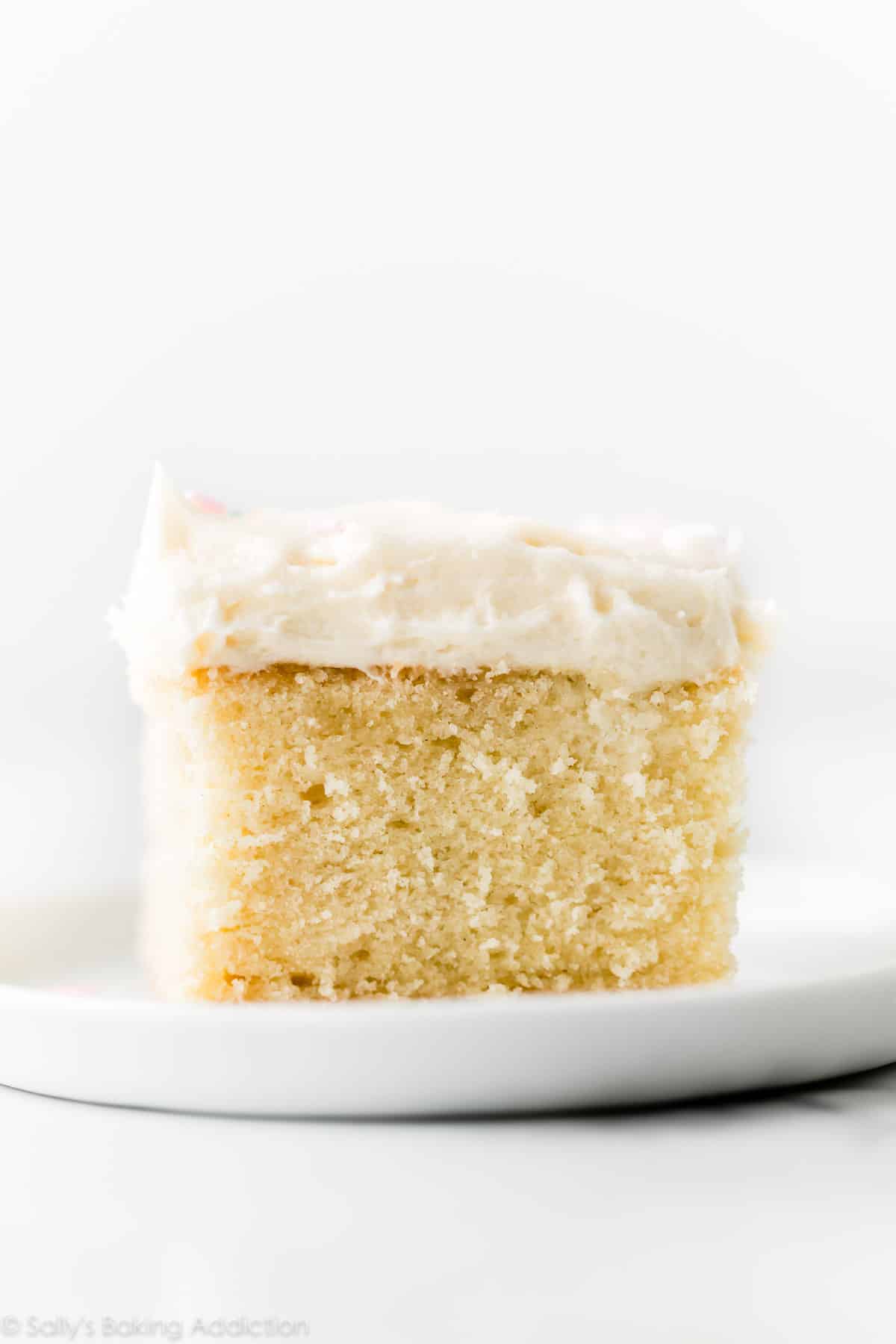
When it comes to classics like vanilla cake, the chapter never really ends. You see, there’s 3 layer vanilla cake, vanilla cupcakes, vanilla naked cake, one layer vanilla cake (aka strawberry shortcake cake!), vanilla 6 inch cake, confetti cake, and even a vanilla white cake hybrid. Each of these recipes use the same ingredients, only remixed and divided in different proportions.
But what about a simple vanilla sheet cake recipe?
That’s what we’re focusing on today. This is a pure and classic vanilla sheet cake with a soft, springy crumb and unbelievable sweet vanilla flavor. It’s the simple birthday cake you need and buttery taste you love. And let’s add a giant fluff ball on top—otherwise known as whipped buttercream. This is dessert nostalgia at its finest!
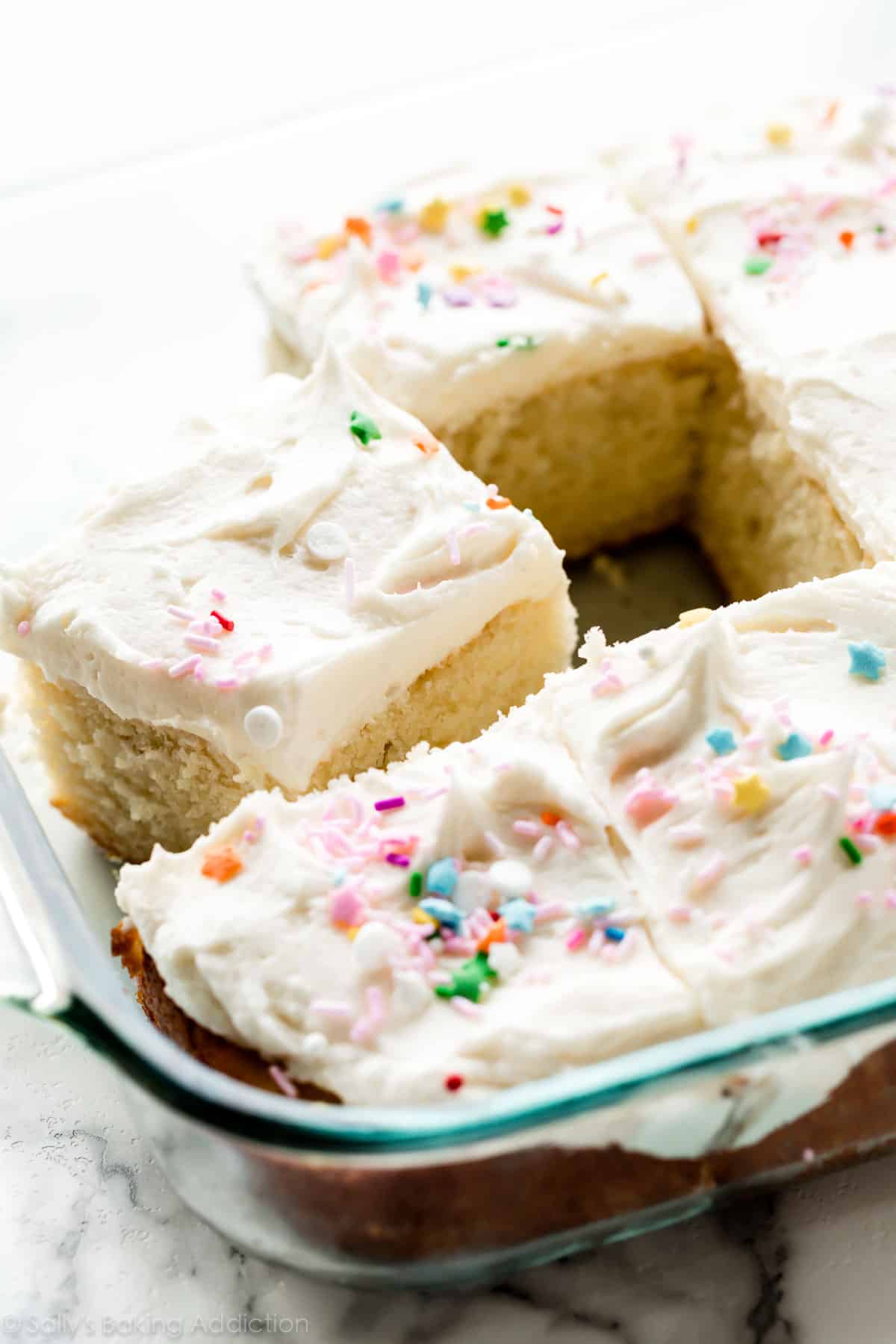
Behind the Vanilla Sheet Cake Recipe
My vanilla cake recipe (the best I’ve ever had!) yields too much batter for a 9×13 inch quarter sheet cake, while the strawberry shortcake cake batter isn’t quite enough. My 2 layer vanilla/white cake hybrid is super light and fluffy and while it’s the perfect amount for a 9×13 inch quarter sheet pan, it doesn’t have the same buttery tight crumb as traditional vanilla cake. For today’s recipe, I took what I love about these cakes and combined them into the appropriate amount of batter to fit this classic size pan.
First, let’s walk through an in-depth tutorial of the mixing method. (Reverse creaming! You’re going to love it.) Though this is a very straightforward recipe, I encourage you to read through my tips before getting started.
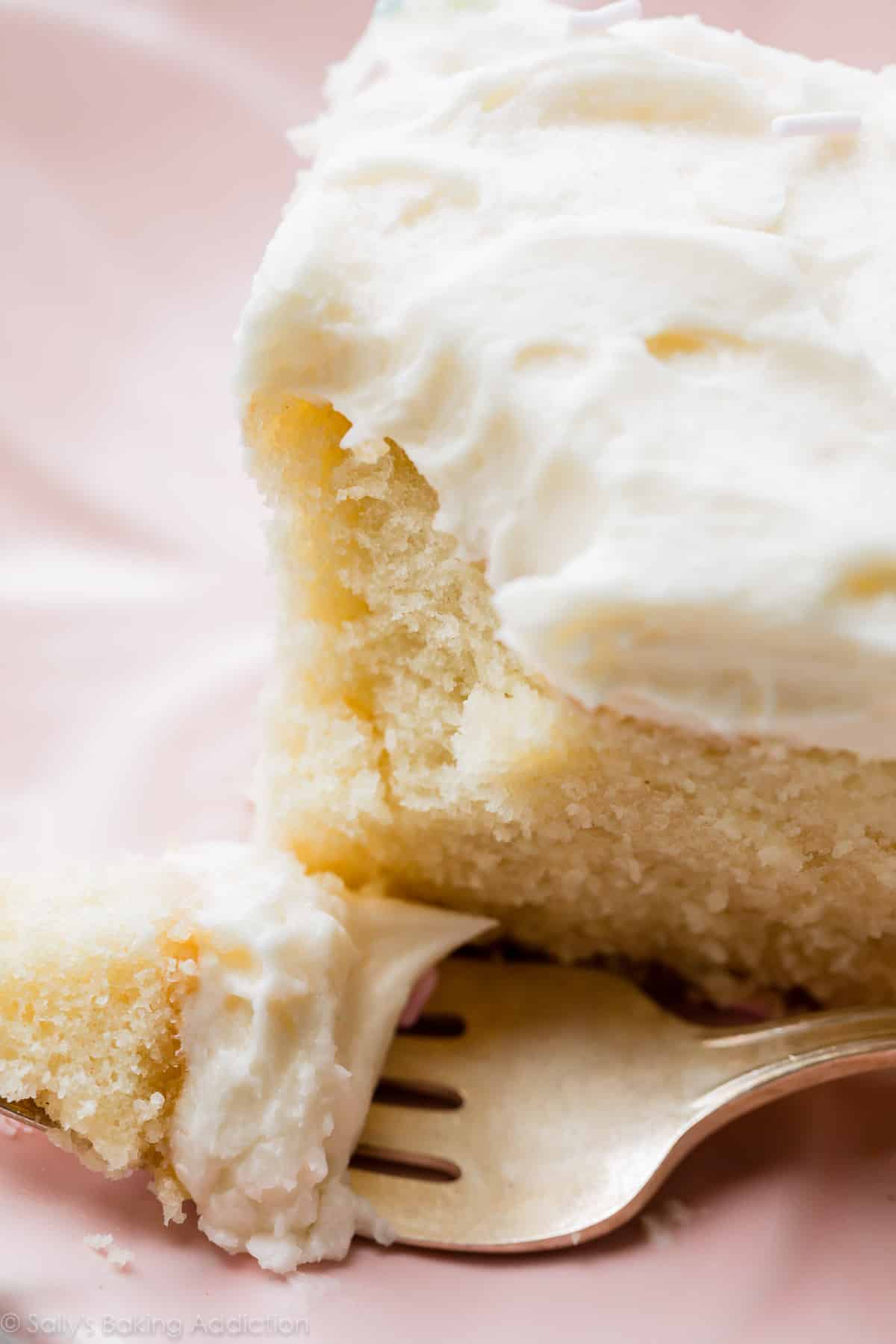
Reverse Creaming Method for Cake
Do you remember when I shared Tessa’s Blackberry Lavender Cake? I just love her recipes! Prior to that cake, I had only used the reverse creaming method a handful of times. I loved her cake’s texture, so I replicated it with my strawberry shortcake cake not long after. We’re going to use the same method with today’s vanilla sheet cake recipe. Instead of starting with creaming butter and sugar together like traditional cake recipes, the reverse creaming method begins with the dry ingredients and ends with the eggs. This method produces a lighter and tighter crumb with more spring. The slices are tight like pound cake, but not dense in the slightest. It’s velvety soft and almost tastes creamy.
This method is so unique, but very easy.
Sift the dry ingredients, including the sugar, into a bowl. Sifting with a fine mesh strainer is imperative because it aerates the dry ingredients and leaves behind larger sugar crystals. Remember, we aren’t creaming sugar and butter together where large sugar crystals are usually broken down. Next, mix in cubed room temperature butter, a little milk, and vanilla extract. In this step, the butter coats the flour. The coating of fat minimizes the flour’s formation of gluten, which helps result in a finer cake crumb. You’ll taste the difference.
By the way, we coat flour with fat when we make biscuits and pie crust too. This practice helps produce an extra flaky (not dense) baked good.
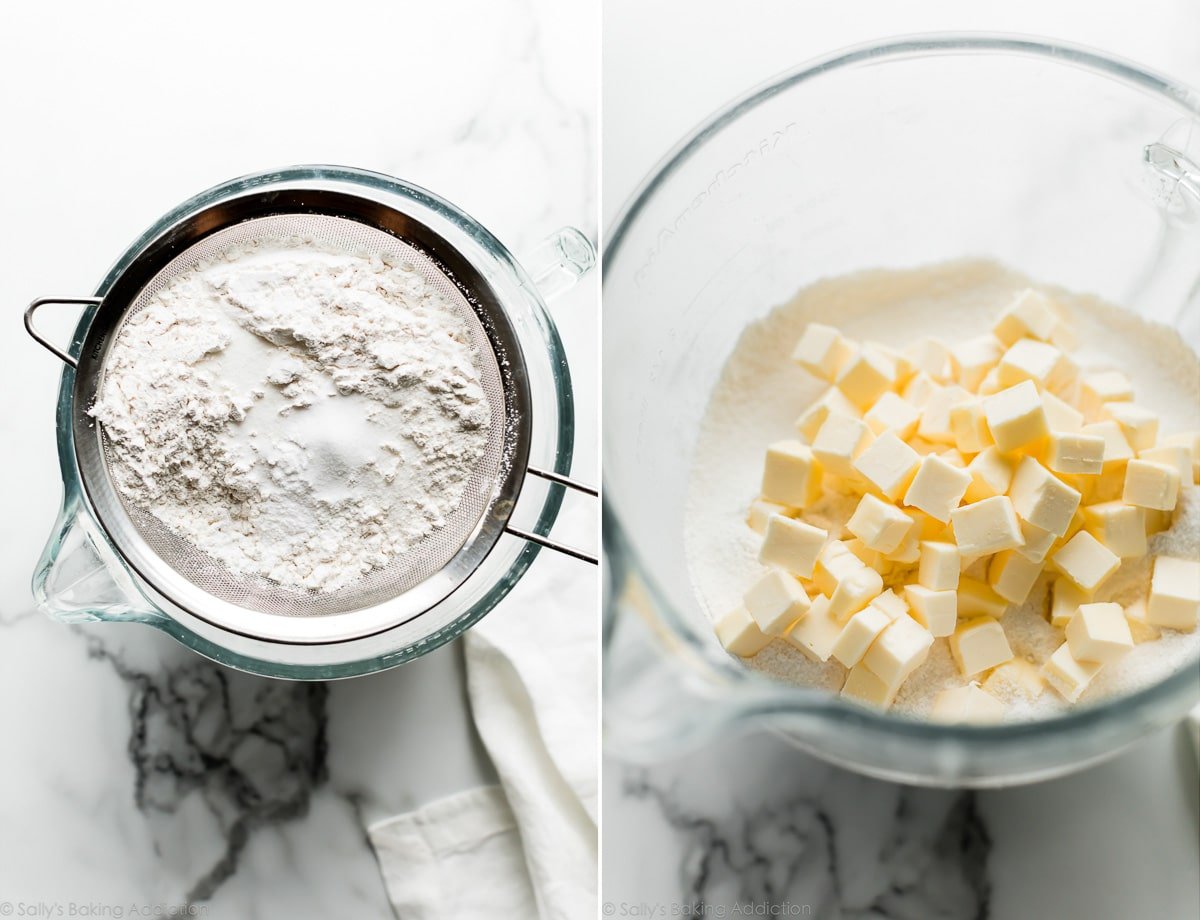
Success Tip: Cube the butter when it’s cold. Smaller pieces of butter will warm to room temperature much quicker than a full stick of butter. Plus, it’s easy to cut cold butter into cubes as opposed to warmer room temperature butter.
After that, we’ll add the rest of the liquids including the remaining milk, the sour cream, and eggs. The photo on the left (below) is our sheet cake batter. I promise it’s the creamiest batter you’ll ever work with. Avoid over-mixing it.
Which Cake Pan?
Use whichever 9×13 inch pan you have on hand. I usually lean towards a glass 9×13-inch pan simply because the cake looks extra beautiful serving right out of the dish. It’s what I prefer when making cookies and cream cake and yellow sheet cake, too. If using a metal baking pan, keep a close eye on the cake. Metal pans usually mean a quicker bake time, though my test recipes (in all different pans) each finished baking around the same time.
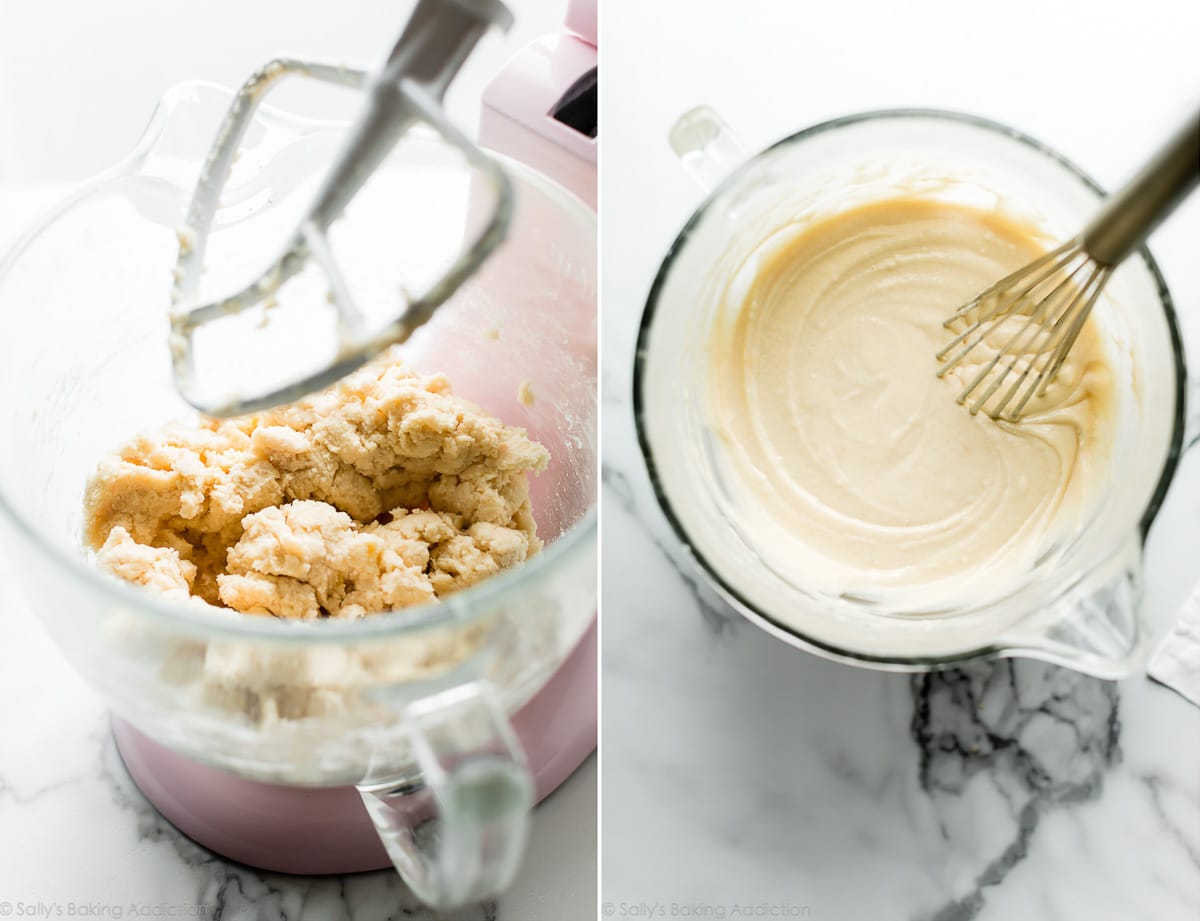
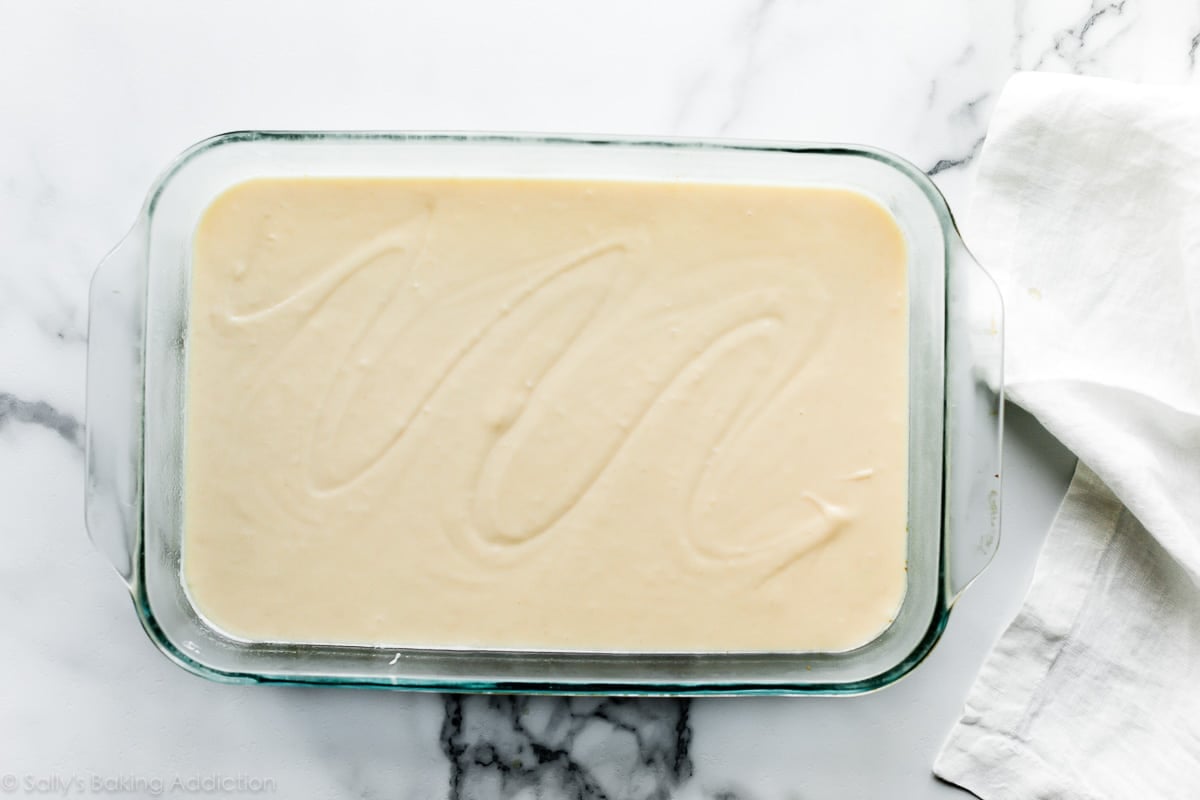
Vanilla Sheet Cake Ingredients
Whether you’re a beginner baker or pro, you’ll be happy to see that this vanilla sheet cake requires only a handful of super basic baking ingredients. Each one serves a purpose and for best results, I don’t recommend making substitutions.
- Cake Flour: Cake flour produces the softest cake. There’s simply no competition, but you can certainly make this cake flour substitute if needed. Cake flour is sold in the baking aisle with the other flours. You can use leftovers in any recipes using cake flour.
- Sugar & Salt: Sugar sweetens the cake and salt adds flavor.
- Baking Powder & Baking Soda: Remember the differences in baking powder vs baking soda and why it’s important to use both in some recipes?
- Butter: Room temperature butter is the workhorse behind this whole recipe, especially the reverse creaming method. It also adds flavor. I recommend using unsalted butter in this sheet cake recipe. If you’re interested, here’s a post I wrote on salted butter vs unsalted butter.
- Vanilla Extract: Vanilla extract adds flavor. Use an entire Tablespoon… trust me! And if you use homemade vanilla extract, even better. 🙂
- Whole Milk: The cake’s crumb is extra rich and we have the whole milk to thank for it. Avoid lower fat or nonfat milks. Moist cakes need fat.
- Sour Cream: The moist maker! Thanks to sour cream, this cake melts in your mouth.
- Eggs: To obtain a fluffier cake, I usually add extra egg whites. However, this sheet cake didn’t need it. Maybe my ratios were off, but my few test recipes proved that this combination of ingredients brought together with the reverse creaming method doesn’t need extra whites. Simply use 3 full eggs. Actually, in one test recipe, I used 4 eggs with no sour cream. The cake tasted heavy, so I ultimately swapped 1 egg with sour cream. The cake is much lighter and moister.
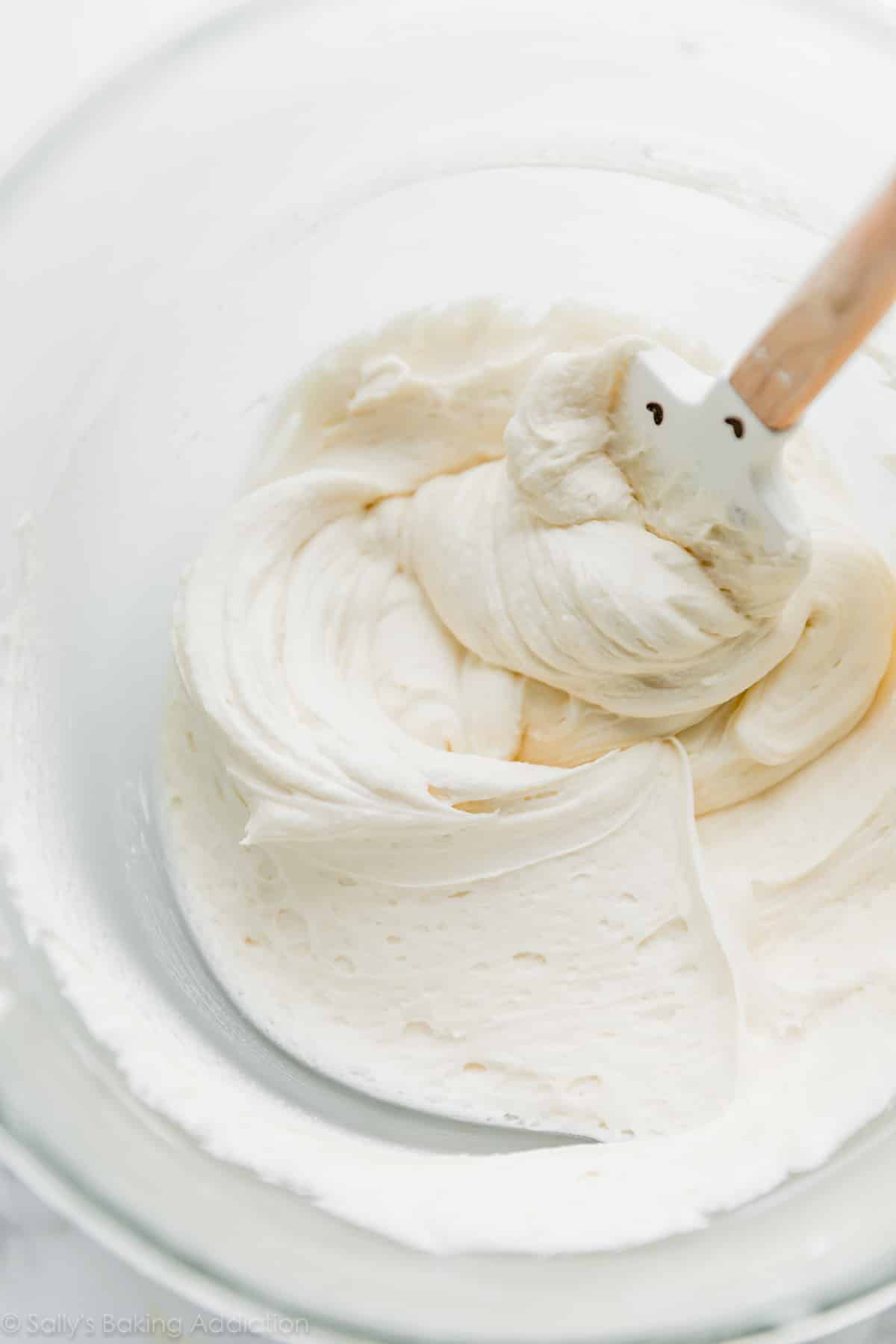
Whipped Buttercream
Elevating this vanilla sheet cake is a lovely blanket of whipped buttercream. Use the same ingredients as my regular vanilla buttercream recipe, but add extra heavy cream and whip it for a few extra minutes. A little extra cream and a little extra whip turn this frosting into a buttercream/whipped cream duo. This is the same frosting we use to fill our cream-filled chocolate cupcakes. It’s mega creamy and fluffy, as if you borrowed a puffy cloud from the sky and slathered it on a cake. Talk about dreamy!
Couldn’t you get lost in these swirls?
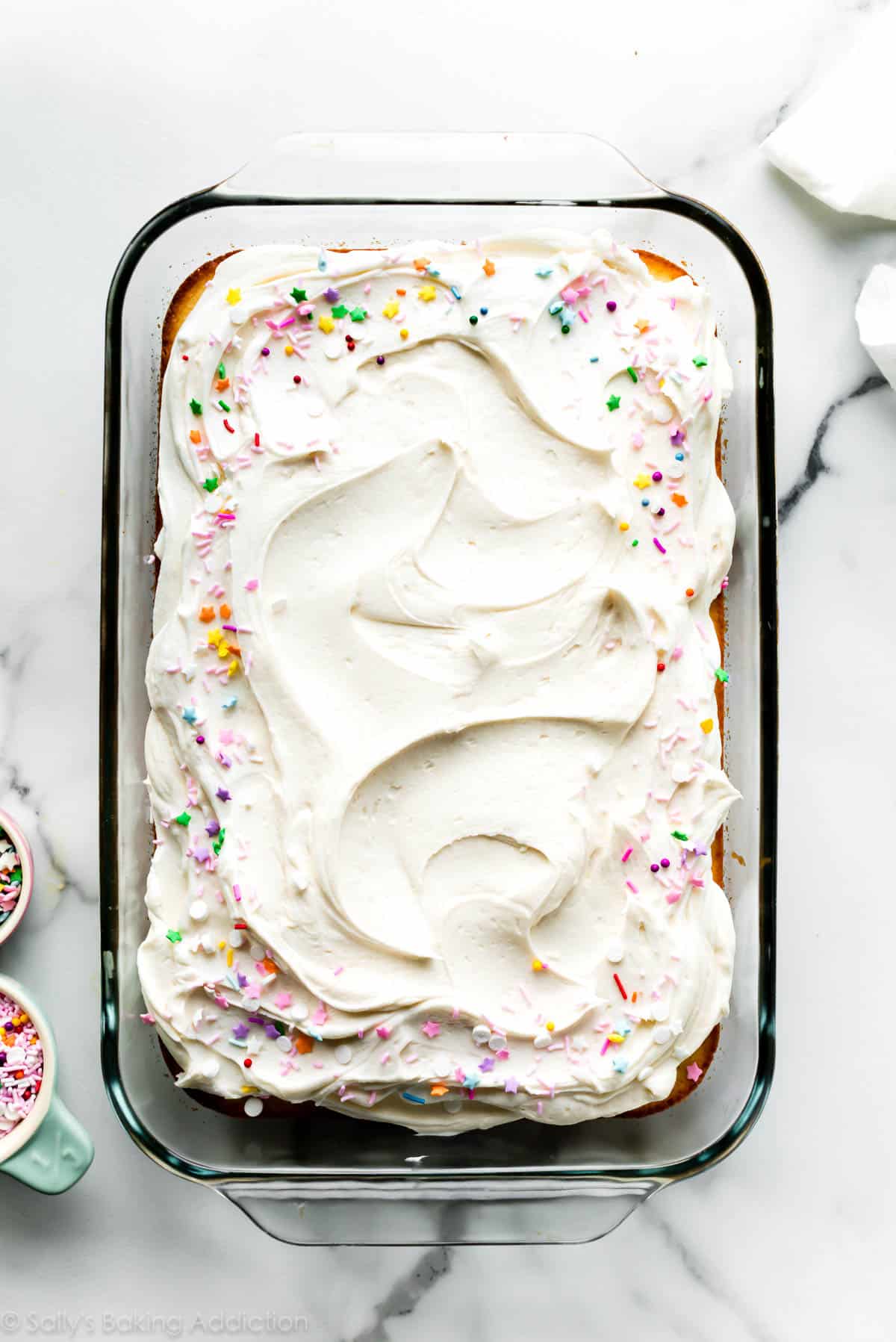
If you want to go the extra mile, top this beauty with thick and fluffy Swiss meringue buttercream instead. For a less sweet option, try my whipped frosting. It’s a personal favorite! And for a pretty pink spin, strawberry buttercream frosting pairs wonderfully with vanilla cake.
Make an American Flag Cake!
Before we finish up, let’s chat about turning this vanilla sheet cake into a flag cake. Spread 2/3 of the frosting all over the cake, saving the remaining 1/3 for piping detail. Grab some fresh blueberries and halved strawberries and line them up to mimic the stars and stripes on an American flag. I used Ateco 32 piping tip for the piping between the “stars” and Ateco 844 piping tip for the piping between the “stripes.”
This would be an excellent choice for Memorial Day Weekend or the Fourth of July. See more Memorial Day Weekend recipes and 4th of July desserts.
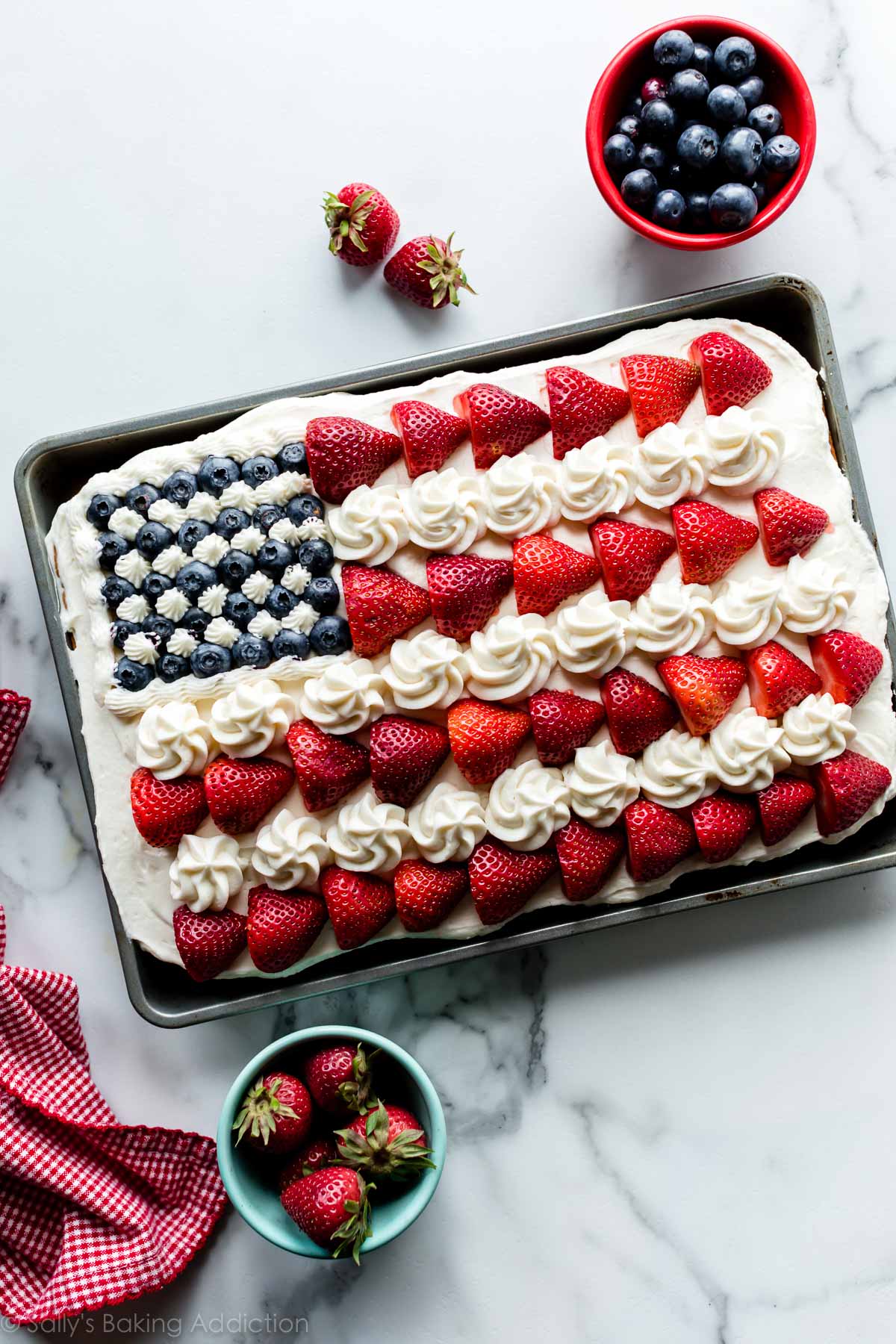
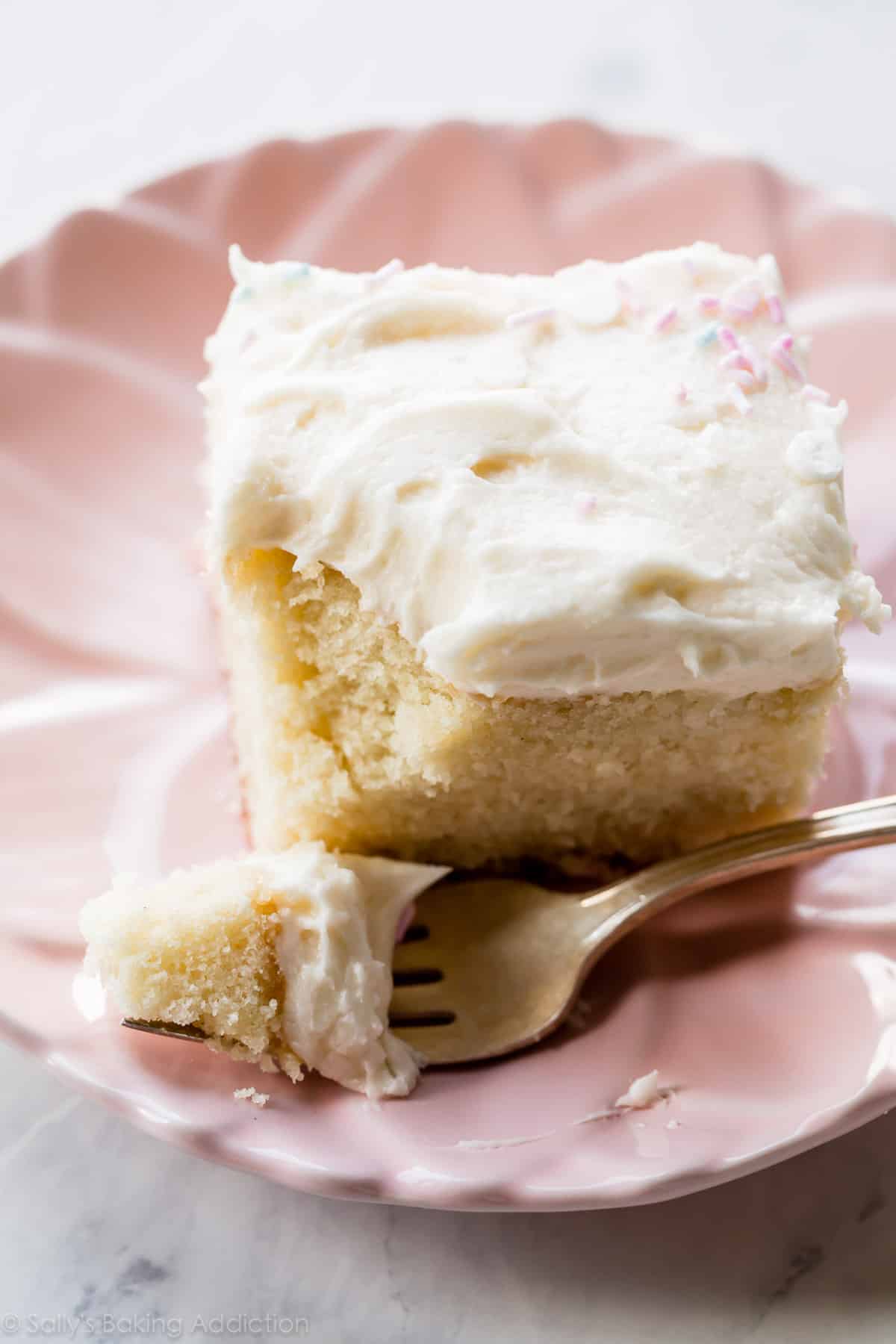
Would love to know if you try this sheet cake!!
More Quarter Sheet Cake Recipes
- Banana Cake
- Pumpkin Cake
- Cookies & Cream Cake
- Yellow Sheet Cake
- Pineapple Carrot Cake
- Spice Cake & Apple Cake
- Zucchini Cake
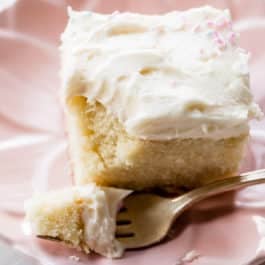
Vanilla Sheet Cake with Whipped Buttercream Frosting
- Prep Time: 20 minutes
- Cook Time: 30 minutes
- Total Time: 4 hours
- Yield: serves 12
- Category: Dessert
- Method: Baking
- Cuisine: American
Description
This vanilla sheet cake recipe uses the reverse creaming method, an easy technique that promises a uniquely soft and springy crumb with the most delicious buttery vanilla flavor. Each ingredient serves a purpose and for best results, I don’t recommend making substitutions.
Ingredients
- 3 cups (354g) cake flour (spooned & leveled)
- 1 and 1/2 cups (300g) granulated sugar
- 1 teaspoon baking powder
- 1/2 teaspoon baking soda
- 1/2 teaspoon salt
- 1 cup (16 Tbsp; 226g) unsalted butter, cubed and softened to room temperature
- 1 Tablespoon pure vanilla extract
- 1 cup (240ml) whole milk, at room temperature and divided
- 1/3 cup (80g) sour cream, at room temperature
- 3 large eggs, at room temperature
Whipped Vanilla Buttercream
- 1 cup (16 Tbsp; 226g) unsalted butter, softened to room temperature
- 4 and 1/2 cups (540g) confectioners’ sugar
- 1/3 cup (80ml) heavy cream
- 2 teaspoons pure vanilla extract
- salt, to taste
- optional: sprinkles for garnish
Instructions
- Make the cake: Preheat the oven to 350°F (177°C). Generously grease a 9×13-inch cake pan.
- Sift the cake flour, sugar, baking powder, baking soda, and salt in the bowl of a stand mixer. (Or if using a handheld mixer, any large mixing bowl.) With the paddle attachment, beat the ingredients together on low speed for a few seconds to gently combine. Add the butter, vanilla, and 1/2 cup of milk. Mix on medium speed until the dry ingredients are moistened, about 1 minute. Stop the mixer and scrape down the sides and up the bottom of the bowl. The mixture will resemble a thick dough.
- Whisk the remaining milk, the sour cream, and eggs together in a medium bowl. With the mixer running on medium speed, add the egg mixture in 3 additions, mixing for about 15 seconds after each addition. Stop the mixer and scrape down the sides and up the bottom of the bowl, then mix for about 15 more seconds until batter is completely combined. Avoid over-mixing. Some small lumps are OK.
- Pour and spread batter evenly into prepared pan. Bake for around 32-35 minutes or until the cake is baked through. To test for doneness, insert a toothpick into the center of the cake. If it comes out clean, it’s done. Allow cake to cool completely in the pan set on a wire rack. The cake must be completely cool before frosting.
- Make the buttercream: With a handheld or stand mixer fitted with a paddle attachment, beat the butter on medium speed until creamy, about 2 minutes. Add confectioners’ sugar, heavy cream, and vanilla extract. Beat on low speed for 30 seconds, then increase to medium-high speed and beat for 4 full minutes. Add up to 1/4 cup more confectioners’ sugar if frosting is too thin or another Tablespoon of cream if frosting is too thick. Add a pinch of salt if frosting is too sweet. (I add 1/8 teaspoon salt.) Frosting should be extra fluffy.
- Spread frosting in a thick layer on cooled cake. I use and recommend an offset spatula. If desired, use a piping tip to pipe some frosting and/or garnish with sprinkles. Slice and serve.
- Cover leftover cake tightly and store in the refrigerator for up to 5 days.
Notes
- Make Ahead & Freezing Instructions: The cake can be baked, cooled, and covered tightly at room temperature overnight. Likewise, the frosting can be prepared then covered and refrigerated overnight. Let the refrigerated frosting sit at room temperature for 10 minutes, then beat with a mixer for 1 minute to bring it back to a spreadable consistency. Frosted cake or unfrosted cake can be frozen up to 2-3 months. Thaw overnight in the refrigerator and bring to room temperature before decorating/serving.
- Special Tools (affiliate links): 9×13-inch Cake Pan | Fine Mesh Sieve | Electric Mixer (Handheld or Stand) | Glass Mixing Bowl | Whisk | Cooling Rack | Offset Spatula
- Cupcakes: Fill cupcake liners 2/3 full. Bake at 350°F (177°C) for 19-21 minutes. Yields about 2 dozen. Or try my vanilla cupcakes recipe.
- 2 Layer Cake: If desired, you can use this batter to make a 2 layer cake instead. Grease two 9-inch cake pans, line with parchment paper rounds, then grease the parchment paper. Parchment paper helps the cakes seamlessly release from the pans. Divide the batter evenly between the pans. Bake time will be a few minutes shorter—keep a close eye on the cakes at 20 minutes and check for doneness with a toothpick.
- Cake Flour: For the best results, I strongly recommend cake flour. You can find it in the baking aisle and I have many more recipes using it. If you cannot get your hands on cake flour, you can make a DIY cake flour substitute.
- Why is everything at room temperature? All refrigerated items should be at room temperature so the batter mixes together easily and evenly. Read here for more information.
- Sprinkle Cake: To make a sprinkle cake, fold about 2/3 cup (105g) of sprinkles into the cake batter. Avoid nonpareils (the little balls), which tend to bleed their color.
- Chocolate Frosting: If desired, swap the whipped vanilla buttercream with chocolate buttercream. The chocolate buttercream calls for beating for 1 minute, but for a fluffy whipped texture, whip for 3 full minutes.





















i’ve made this 3 times for different events and each time, i simply get raves! i don’t love buttercream frosting so the last time, i used one stick of butter, not two. it was better.
Is it possible to make this in a 12×18 inch pan? If so, would I need to double the recipe?
Hi Rebecca, here’s everything you need to know about cake pan sizes and conversions.
Will 5% fat plain greek yogurt work in place of sour cream? Thank you
Hi AJ, that will work in a pinch.
Hello! If i wanted to make this into a lemon sponge, would you recommend adding just lemon zest or lemon juice/extract too? Thank you
Hi Sophie, We recommend using our lemon cake recipe instead! See recipe notes for details on baking in a 9×13-inch pan.
Is this cake strong enough so that I can stack two of them with frosting in between?
Hi Kaelin, absolutely‚ this cake is quite sturdy so that shouldn’t be a problem.
Is the frosting recipe enough for a 9 inch 3 layer cake?
Hi Esther, you may want to 1.5x the recipe to be sure you have enough.
Hi Sally! I absolutely love this recipe, but I have a question. When I bake it in a single layer, it comes out perfect. However, I prefer to bake my cakes in a 3″ tall pan so that I can slice them in half and create four layers.
When I bake the cake taller, the texture turns out coarse, almost like cornbread, and there’s a navel in the middle. Everything else stays the same—just a different batter amount and a taller pan. Do you have any idea what could be causing this?
Thank you in advance!
Hi Jaina, it could be that there is simply too much batter in the pan. When there is more batter, it becomes more difficult for the batter to bake evenly. If you’re multiplying the batter, over mixing could also be to cause for the overly dense and cornbread-like texture. This cake is already on the denser side, so we’d recommend making the recipe as-is, but two separate batches and then stacking the cakes from there. Hope this helps!
Hi – this recipe looks amazing! How long can the whipped vanilla or strawberry buttercream be left out at room temperature before serving?
Hi Mai, we haven’t had any issues leaving the frosted cake out for about 24 hours, but after that we’d recommend storing in the refrigerator.
Will this recipe work in a 12×18 cake pan if I bake for less time, maybe around 20 minutes?
Hi Stacy, our post on cake pan sizes and conversions will be helpful. We’re unsure of the exact bake time, so keep a close eye on it and use a toothpick to test for doneness.
I made this cake in a 11×13 pan. Do I have to 1.5 the frosting or double it?
Hi, I think 1.5x will be plenty.
All of the sheet cakes I see on your page look like they are frosted and served from the sheet pan. I need to make an 11 x 15 cake that will be turned out of the pan and frosted on the sides and top. Do you have a recipe that works well for that?
Hi Kristie, You can try making 1.5 times the recipe although you might have a bit of leftover batter (which you can use to make a few extra cupcakes!). For a precise calculation using a different size pan you can use the post Cake Pan Sizes & Conversions to help calculate how much batter you would need.
Great! I will try it this week? Thank you.
I ended up doing 2 full batters since I was turning the cake out of the pan and frosting it, and that worked perfectly. But the taste of this cake, oh my heavens to Betsy – it is WONDERFUL!!! I will definitely make this often!
It was so delicious! I have never baked a cake from scratch before!
This was the best white cake recipe ! It was the perfect cake for my daughter’s baby shower. I will definitely use this recipe for all my white/ vanilla cake needs from now on.
Is it okay to use cane sugar instead of granulated sugar?
Hi Marie, pure cane sugar *should* work just fine in this recipe. The granules are a little larger so it’s possible there could be some grittiness, but it shouldn’t be an issue. The cake may also be a bit darker in color, since cane sugar isn’t pure white like granulated sugar.
The instructions were super simple to follow (even having only done the reverse creaming method maybe a couple of times before), I was super impressed by how it turned out– it was like a Betty Crocker angel food cake mix. Will definitely be making this again in the future!
Hi Sally, can I double this to make 2 cakes or would I be better off just making it twice? thanks so much.
Hi Sarah, for best results, we recommend making 2 separate batches rather than doubling.
I love your recipes!
I am planning on using this recipe for a dinosaur cake pan for my daughters birthday. The dimensions are 2″Dx11″Wx12″H that should be fine right?
Hi Kevin, here’s everything you need to know about cake pan sizes and conversions. Hope the cake is a hit!
I’m making this cake for my son’s 1st birthday party next week! It sounds delicious and I am never disappointed with any of your recipes, thank you! I am planning to double this recipe and using a 12×18 disposable tin baking pan. Do you think I will have any issues with an even bake??
Thanks!!
Hi Allie, we haven’t tested it, so can’t give you an estimate on the bake time, but it will definitely take longer. I would recommend rotating the pan halfway through, to help it bake evenly. And here is everything you need to know about converting recipes to different cake pan sizes. Hope the party goes well!